
![]() When completed in August 1959 on the Clyde by the Alexander Stephen yard, the stylish closed shelterdecker City of Melbourne was the lead ship of a sextet of cargo-liners with enclosed poop decks and the most powerful diesel engines yet built in Britain. City of Melbourne achieved over 19.9 knots on trials at 116.4 rpm from a Stephen-Sulzer diesel of 14,000 bhp. She was built for the homeward refrigerated meat, grain, wool, and hides trade from Australia with speed as her primary selling point. She was a handsome and elegant ship with five holds and a hatch between the bridge and the funnel trunked down to number four upper and lower ‘tween decks and hold. She had a big cubic capacity of 724,930 cubic feet of which 164,260 cubic feet was for the carriage of refrigerated meat, a trade she would participate in for nine years before the introduction of refrigerated container ships on the Australasian Conference trade routes.
When completed in August 1959 on the Clyde by the Alexander Stephen yard, the stylish closed shelterdecker City of Melbourne was the lead ship of a sextet of cargo-liners with enclosed poop decks and the most powerful diesel engines yet built in Britain. City of Melbourne achieved over 19.9 knots on trials at 116.4 rpm from a Stephen-Sulzer diesel of 14,000 bhp. She was built for the homeward refrigerated meat, grain, wool, and hides trade from Australia with speed as her primary selling point. She was a handsome and elegant ship with five holds and a hatch between the bridge and the funnel trunked down to number four upper and lower ‘tween decks and hold. She had a big cubic capacity of 724,930 cubic feet of which 164,260 cubic feet was for the carriage of refrigerated meat, a trade she would participate in for nine years before the introduction of refrigerated container ships on the Australasian Conference trade routes.
Ellerman Lines Post-World War II
Ellerman Lines Ltd. was established on 22nd January 1902 and became one of the greatest shipping groups in the world with a big fleet of 102 ships on the outbreak of war in September 1939. A dozen of these were passenger and cargo-liners with accommodation for up to 350 passengers on the worldwide empire of trade routes of its City, Hall, Bucknall, Westcott and Laurence, and Papayanni Lines. These were big six hold ships with a gross tonnage of around 10,000 and deadweight of up to 12,500 tons and service speeds of up to sixteen knots e.g. City of Nagpur, City of Paris, City of Simla, City of London and City of Exeter, and the turbine powered twin funnelled City of Benares of 11,081 grt delivered in 1936 by the Barclay, Curle yard on the Clyde. They were used on the route to India and were good, steady vessels carrying large amounts of cargo and passengers.
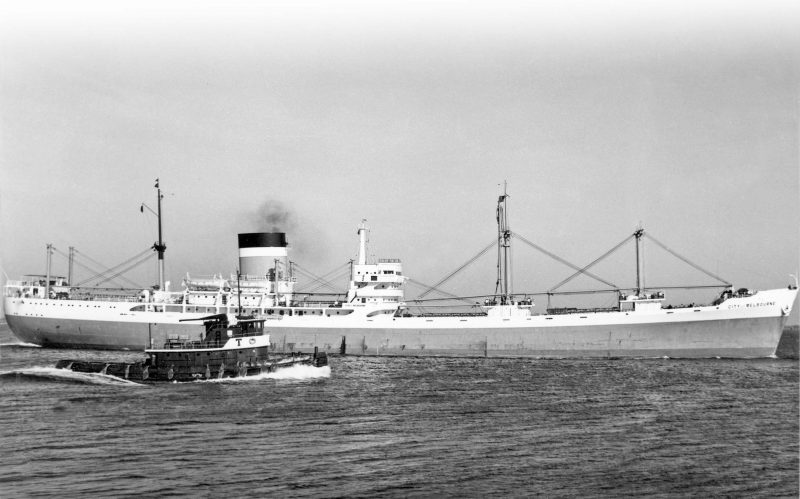
Apart from six ‘Standard Fast’ cargo-liners built at the end of the war in 1945, all of the many post-World War II Ellerman classes of cargo-liner were five hold ships with a maximum of twelve passengers carried, the only exception being the handsome City of Port Elizabeth class of four ships for the South African trade with accommodation for 107 passengers. This in reality was a ploy by Ellerman to gain priority berthing for the lucrative homeward cargoes from South Africa in their usually congested ports.
The five units of the City of New York class of 1947 were followed by the ten units of the City of Oxford class during 1947/49, the three units of the City of Birkenhead class in 1950/51, the big City of Brisbane and City of Winchester of 13,250 dwt in 1951/52, and the six units of the City of Newcastle class in 1956. A dozen workhorse standard ‘Liberty’ types and a few purchased ‘Empire’ standard types, and other cargo-liners purchased from British owners made up the devastating losses suffered by the fleet at the hands of Nazi Germany. The Ellerman fleet had been rebuilt into a large modern fleet of ninety cargo-liners including the first of an octet of smaller four hold shelterdeckers of 7,770 dwt of the ‘Cathedral Cities’ class, operating worldwide by the time the City of Melbourne took to the water on Tuesday 21st April 1959 at the Linthouse yard of Alexander Stephen & Sons Ltd. as Yard number 651. The hull construction period of eight months involved the erection of 188 vertical frames, longitudinal framing at the double bottom, eight bulkheads, five holds, Shelter Deck, Second Deck, Third Deck, poop decks and fo’c’stle deck and steelwork of the superstructure, Captain’s Bridge and Navigating Bridge.
Design And Specification Of City Of Melbourne
The design of fast cargo-liners in the 1950s by British naval architects and drawing room staff took up to two years to produce, and cut down their useful working lives to only twelve to fifteen years in service, as they had usually been superseded by advances in modern cargo transportation. City of Melbourne was given a raked bow, cruiser stern with a partially enclosed poop deck, three masts, and nineteen cargo derricks, with her superstructure arranged aft of ‘midships to suit the position of the machinery. The hull was subdivided into five main cargo holds, with corresponding lower and upper ‘tween decks for the carriage of chilled or frozen meat and fruit cargoes as well as in number four hold. Deep tanks were incorporated between numbers two and three holds for the carriage of latex, mineral oil, vegetable oil or general cargo, and were coated with vinyl lacquer. A rotary electric pump in a separate pump room, working at a rate of 100 tons per hour was provided for the loading and discharge of these liquid cargoes. Grain in bulk was usually carried in numbers one and five holds, and lower ‘tween decks, as well as in the deep ballast tanks when suitably fitted out.
City of Melbourne had a length overall of 545.1 feet, length between perpendiculars of 510.0 feet, moulded beam of 71.0 feet, depth to Shelter Deck of 43.6 feet, depth to Second Deck of 33.6 feet and a loaded draft of 28.9 feet at her corresponding deadweight of 12,300 tons. The fo’c’stle was of length 45 feet, and the poop deck much longer at 95 feet. She carried 4,400 tons of water when in ballast, and 2,500 tons of fuel oil and diesel oil when her cross bunker, settling tanks and forward and aft double bottom tanks were full. The double bottom was subdivided into eighteen tanks between the fore peak tank and the aft peak tank, with twenty further deep fuel and water ballast tanks.

City of Melbourne had a suite of rooms for her Master including a dayroom, bedroom and bathroom on the Captain’s Bridge, panelled in French walnut veneers with sycamore trim. The Navigating Officers and Radio Officer were accommodated in large cabins to port and starboard of the forward end of the Boat Deck, while the Chief Engineer and the other engineering officers were housed on the forward end of the poop deck. The engineers relaxed in a Smoking Room with comfortable armchairs, the room panelled in fiddle back sycamore with African mahogany trim. Cabins in the ‘midships house on Shelter Deck were provided for the purser, junior navigating officers, cadets and petty officers. There was also a hospital and a surgery for the European crew. A large pantry and well equipped galley were situated close to the Dining Room, which was on the starboard side of Shelter Deck and panelled in Australian silver ash, with the window surrounds in toned sycamore and the glazed entrance door trimmed with Queensland walnut. A small Duty mess panelled in azure blue warerite was adjacent to the Dining Room. The Asian crew were housed in four berth cabins on the Shelter Deck and Second Deck with their twin Asian galleys aft on the poop deck. The ventilation and heating of both the European and Asian crew cabins and galleys was provided by special heaters and exhaust systems, as well as air conditioning in the Dining Room, Duty mess, Smoking Room and European crew hospital.
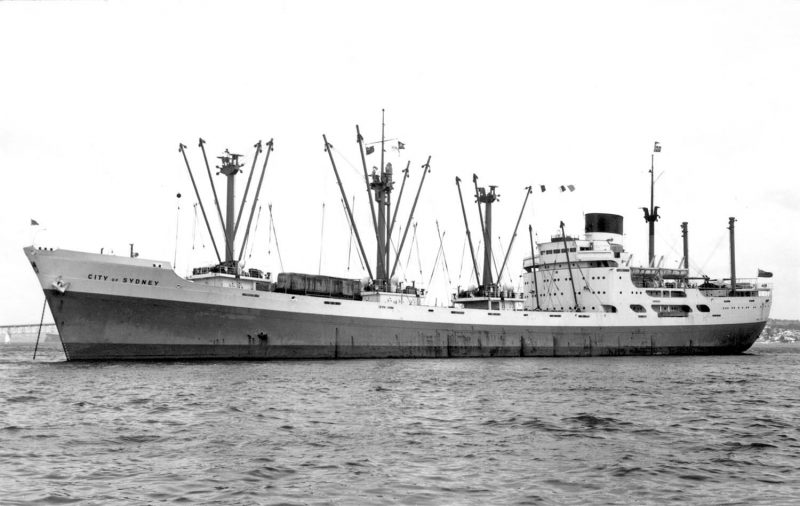
The cargo derricks of six 5-ton, four 7-ton, eight 10-ton and one heavy lift derrick of twenty tons capacity were worked by Clarke Chapman of Gateshead electric winches except for two worked by contactor type winches. MacGregor sliding steel hatch covers were fitted to the weather deck hatchways, and MacGregor flush hinge covers were installed for the hatchways serving number four insulated hold. Hastie steering gear was fitted, controlled from the wheelhouse by telemotor and mechanically from the poop deck. Four glass fibre lifeboats were carried, one of which had a motor, slung from davits. The cargo spaces and engine room were fitted with combined fire and extinguisher systems connected to smoke detector cabinets, one in the wheelhouse and the other in the carbon dioxide cylinder room. The cooling air system was supplied by J. & E. Hall Ltd. of Dartford from a refrigeration plant on the starboard side of Second Deck, and protected all of the chilled beef and fruit holds and ‘tween deck spaces.
The vessel was heeled at the fitting out berth for trim and stability checks, the submerged surfaces of the hull having already been protected against corrosion by a cathodic protection system. The bridge was fitted with the latest navigation equipment including Lodestone radar, direction finder and radio systems, Decca Navigator, Sperry gyrocompass, magnetic compass, Arkas autopilot, Marconi echo sounding gear, with engine and steering telegraphs on both sides of the bridge. The radar scanner was fitted at the top of a white pole above the navigating bridge. An aluminium sun awning was fitted over the poop deck for the long periods spent crossing the tropical areas of the world. In general, City of Melbourne was a well designed British cargo-liner that benefitted from one hundred years of experience in carrying valuable general and refrigerated cargoes across vast distances of the world.
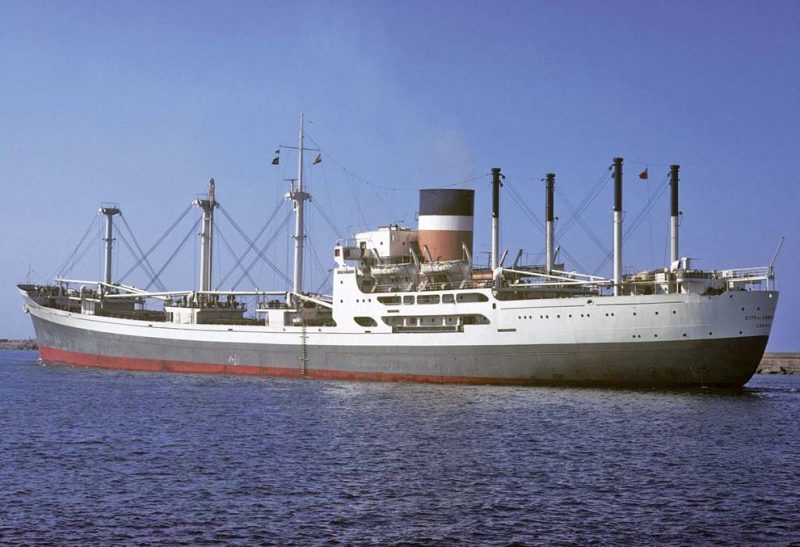
Propelling Machinery
A giant of a big twelve cylinder Sulzer diesel engine towered thirty feet above the engine bedplates in the engine room, and weighed in at 1,510 tons. It was constructed by the shipbuilder under licence from Sulzer Brothers Ltd. of Winterthur in Switzerland and was the most powerful diesel engine yet built in the United Kingdom. The big diesel engine was designed to burn heavy fuel oil at sea, with diesel oil used in harbour, by this two stroke cycle diesel, with 760 millimetre cylinder diameter and stroke of 1,550 millimetre, rated at 14,000 bhp at 114.5 rpm. A testbed of the engine under workshop conditions actually developed 18,220 bhp at 126.04 rpm for a maximum period of twenty minutes, but testbed conditions are quite different from those experienced in real life at sea.
The layout of this big diesel engine on the centreline of the engine room of the City of Melbourne had four Sulzer turbo blowers on the starboard side, each turbo blower having a turbine wheel and a blower impeller on one shaft, and was supplied with exhaust gases by separate pipes from three cylinders of the diesel engine. The electrical switchboard, fuel oil purifier room, lubricating oil renovating tanks and one of the two air receivers were on the starboard side of the engine room, with the other air receiver and the engineers’ store and workshop, fuel valve cooling pumps, oily water separator, and lubricating oil storage tanks on the port side. Fuel oil deep tanks and settling tanks were also present on both sides of the engine room, with fuel booster pumps situated at the front end of this giant diesel engine.
City Of Melbourne In Service
The maiden voyage in August 1959 was in ballast to the St. Lawrence to load lead bullion and ingots for Australia, bunkering at Curacao on the way and then transitting the Panama Canal to Brisbane and Melbourne for discharge and then reloading with grain, wool and refrigerated meat. She sailed across the Indian Ocean for Aden for bunkers and then transitted the Suez Canal with a full cargo of 11,445 tons for Rotterdam. She coasted down the English Channel to Liverpool to unload the last of her cargo. She repeated this voyage by ballasting to the St. Lawrence to load lead ingots for Port Pirie at the head of the Spencer Gulf and for Geelong near Melbourne. She again loaded grain, wool, refrigerated meat and hides to out-turn a full cargo of 12,300 tons for British and Continental ports, bunkering on the way at Aden. She then underwent her guaranteed builders’ dry docking to assess her hull condition, engine performance and make minor adjustments.
City of Melbourne made over thirty round voyages in the Canadian and Australian trades, including several voyages on the MANZ Line service from Montreal to Australia and New Zealand. Ellerman and Bucknall Line owned one third of the shares in the service along with Port Line and New Zealand Shipping Co. Ltd. MANZ Line ended in 1969 shortly after the introduction of refrigerated container ships to Australia, and she was then switched to the South African trades in 1968 and renamed City of Cape Town. She sailed alongside the handsome passenger carrying quartet of City of Port Elizabeth, City of York, City of Durban and City of Exeter for three years until this quartet were sold off in 1971 to Greek owners for conversion into ferries, although only two of the quartet actually emerged as ferries on the Patras to Brindisi and Ancona route as Mediterr-anean Sea and Mediterranean Sky.

In 1978, City of Melbourne was sold to Atlantic Gold Shipping (Pte) Ltd. of Singapore and renamed Otagold, and was given a white hull and a white funnel with a black top bearing the outline of her new owners logo. She was used in the Far East tramp trades for a year, arriving at Manila in the Philippines from Singapore in late October 1978. She was then sold for breaking up at Kaohsiung and moved up to the breakers yard through the narrow entrance of Kaohsiung port on 22nd May 1979. She had given twenty years of worldwide trading, but basically was now uneconomic in operation due to the huge hike in fuel oil prices by OPEC in late 1973.
Five Similar Vessels To City Of Melbourne
This quintet were not full sisters of City of Melbourne, but shared the same design of enclosed poop decks of these best examples of late British cargo-liner design. City of Sydney and City of Canberra came from the Barclay, Curle yard at Glasgow in 1960/61, City of Eastbourne and City of Glasgow from the Walker Naval Yard of Vickers Armstrong Ltd. on the Tyne in 1962/63, and finally City of Adelaide from the Barclay, Curle yard at Glasgow in January 1964. They had an overall length of 511.0 feet, moulded beam of 67.0 feet, depth of thirty feet and draft of 29.0 feet when fully loaded. They were powered by eight or nine cylinder two stroke single acting Sulzer diesel engines of around 11,700 bhp to give service speeds of eighteen knots on their Far East, Australian and South African Conference Line trades. They could carry 11,500 tons of cargo and deliver it at the same speed as the other fast cargo-liners of the Conference partners.
They had five holds served by five hatches, except in the case of the Tyne built City of Eastbourne and City of Glasgow where six hatches were installed to serve the five holds and an extra mast was given to this pair. The cross hatch between the navigating bridge and funnel of City of Melbourne was omitted in the design of the quintet, and instead the composite superstructure was joined to the enclosed poop deck of length varying from 60 to 76 feet, and with a fo’c’stle varying in length from 44 feet to 96 feet. They had three complete decks, namely Shelter Deck, Second Deck and Third Deck beneath the Poop/Fo’c’stle Deck and above the holds, tank tops and tunnel tops.
All of the quintet were used on the Australian service, with City of Eastbourne and City of Glasgow also used on the South African service. City of Glasgow was altered in 1964, a year after her completion, at Newcastle Quay by Tyneside shipyard workers, who added a private owners suite in the Officers accommodation for Sir John and Lady Esther Ellerman (nee Esther de Sola) to travel to Cape Town to stay at his newly purchased Ellerman House, with magnificent views over the sea. A grand piano was included in the owners suite, with Sir John, Lady Esther and a group of friends embarked at Southampton for the voyage.
Unfortunately, Sir John and Lady Esther Ellerman made only one voyage to Cape Town in the suite, as they considered the diesel powered ship too noisy with much vibration, and preferred to travel in a quieter turbine powered vessel e.g. City of Oxford and City of Ottawa. The latter pair were retained in the fleet after the sale of their sisters until 1976 for this very reason, along with three sets of steam engineers as Ellermans had a policy of having three crews for every two ships. The owners suite in City of Glasgow remained locked up for the remainder of her Ellerman Line service. The Cape Town house had been built in 1906 in the ‘Cape Edwardian’ style as the first private residence in Cape Town with a lift. After the death of Sir John Ellerman in 1973, the house reopened in December 1992 as a seven bedroom hotel after extensive renovation, and today is known as the Ellerman House Villa with a beautiful garden and an art gallery.
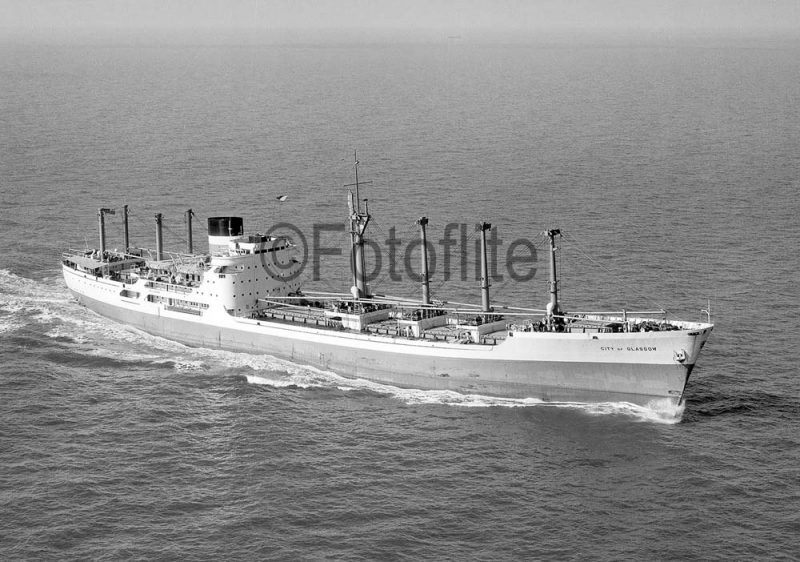
City of Eastbourne and City of Glasgow were given a different mast and rigging arrangement from their Clyde built sisters, in that the forward four holds were served by four masts, namely from the number one hold the Foremast, Mainmast, Mizzenmast and a tall Jigger Mast between numbers three and four holds. The outfit of steel derricks of lengths varying from 56 feet and 65 feet included four of five tons, fourteen of ten tons, and one heavy lift derrick of twenty tons capacity. The tall Jigger mast housed the twenty tonner and four of the ten tonners, with their winches on a raised square shaped platform, with a radar scanner positioned half way up the mast and electric and oil steaming lights at the top of the mast. A steel ladder inside the Jigger allowed access to the halyards and block tackle at the top of the mast.
City of Eastbourne was launched on 7th November 1961 and sailed on her maiden voyage from the Tyne in March 1962, followed into the water by City of Glasgow when launched on 11th December 1962 and her maiden voyage starting in April 1963. Their powerful diesel engines were manufactured by Vickers Armstrong Ltd. at Barrow, and looking upwards from the engine room, a swimming pool had been added on the poop deck abaft the engine room skylights and sandwiched between two winches for five ton derricks and looking over number six hatch.
The Tyne built pair had the same accommodation layout for Navigating Officers and Engineering Officers as on City of Melbourne, with the Chief Officer, Radio Officer and Ship’s Office on the port side of Boat Deck, with Second, Third and Fourth Officers and two cadets on the starboard side and the cadet’s study behind their cabin. There were three lifeboats of length 56 feet for 52 persons and one motor lifeboat of the same length for 48 persons. The Captain’s Bridge housed his bedroom and the Radio Room on the starboard side, and his bedroom, bathroom and the Pilot Room on the port side. The deck and handrails of both the open areas of the Captain’s Bridge and the Navigating Bridge and wheelhouse were covered with or made of teak. The monkey island above the Navigating Bridge and wheelhouse had a compass platform and gyrocompass repeater. The wheelhouse had the same array of useful navigational aids as on City of Melbourne.
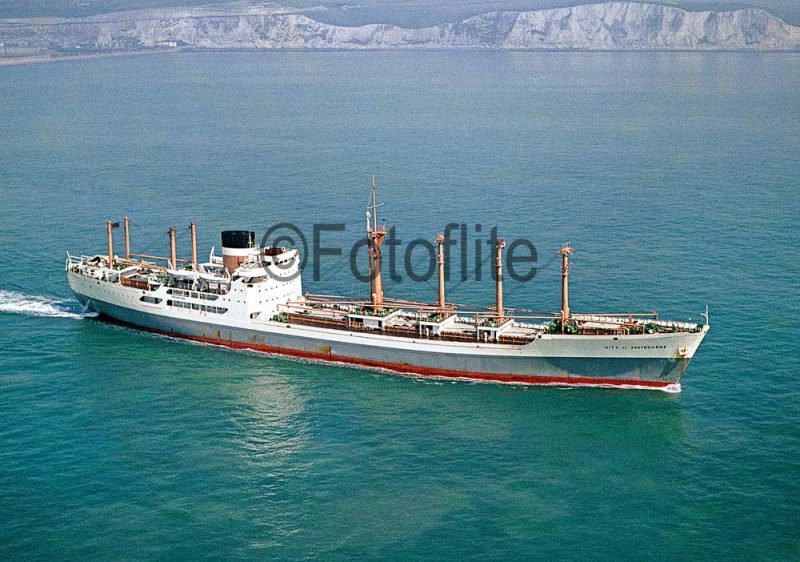
The Ellerman Quintet In Service
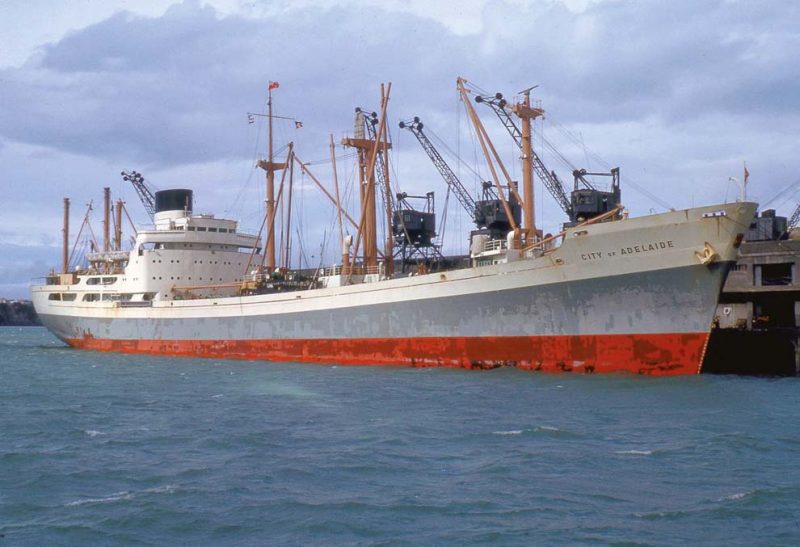
Most of this quintet made voyages on the MANZ Line service from Montreal to Australia and New Zealand, usually two voyages at a time before being transferred to other Ellerman trades, as all Ellerman ships, except the four City of Port Elizabeth class, were interchangeable on routes. City of Glasgow was employed on MANZ Line, and also operated on the Hall Line berth to India and Pakistan as well as making two four month duration voyages from U.K. ports to the Far East, one starting in August 1963 and the other in June 1965. Three years later, she was employed on the Hall Line berth from Glasgow direct to Indian ports via the Suez Canal, returning from India via Mombasa and Cape Town to Montreal on occasions. City of Canberra made two voyages on MANZ Line service in 1965, she could be identified by her topmast on her third mast whereas City of Sydney had topmasts on two of her masts. The Conference Lines that Ellerman participated in during the 1960s were shared with cargo-liners from the big fleets of T. & J. Harrison, Ben Line, Port Line, P. & O., Furness Withy Group, Blue Star Line, British and Commonwealth Group and other famous British shipping companies.
City of Eastbourne, City of Glasgow and City of Sydney were transferred from the Australian service to the Ellerman Canadian City Line service on 1st January 1971 and renamed City of Toronto, City of Ottawa and City of Montreal respectively. This was a joint venture between Ellerman and Bucknall and McLean, Kennedy Ltd., the Ellerman agents in Montreal, for a service between East Coast Canadian ports and South African ports to Calcutta. Funnel colours became red with a Canadian red maple leaf enclosed within a very large white diamond. City of Adelaide was taken on a twelve charter by Hamburg Sud in 1972 and renamed Cap Cleveland, and was renamed City of Canterbury. This was a portent of things to come, as thirty years later the remnants of the great Ellerman Line fleet were also sold to Hamburg Sud of Germany. City of Canterbury and City of Montreal (ex City of Sydney) were the first of the quintet to be sold to new owners in 1976/77, with the former City of Adelaide becoming Rubens for Compagnie Maritime Belge (CMB) for South American services and the former City of Montreal went to Panamanian owners and was renamed Yat Fei. City of Canberra was sold in 1978 to the Tasman Gold Shipping (Pte) Ltd., Singapore and was renamed Tasgold, and the remaining pair of the former City of Eastbourne and City of Glasgow were also sold during that year to Singaporean owners Pacific International Lines (PIL) to become Kota Cantik and Kota Cahaya respectively. They soon were sold to Kaohsiung and Chinese shipbreakers, their final days afloat ended at:-
- City of Sydney of 1960 arrived at Kaohsiung on 25th May 1979 as Yat Fei
- City of Canberra of 1961 arrived at Kaohsiung at the end of October 1980 as Tasgold
- City of Eastbourne of 1962 arrived at Kaohsiung on 16th October 1984 as Kota Cantik
- City of Glasgow of 1963 arrived at Nantong in China on 31st July 1985 as Kota Cahaya
- City of Adelaide of 1964 arrived at Chittagong on 28th August 1983 as A.L. Pioneer
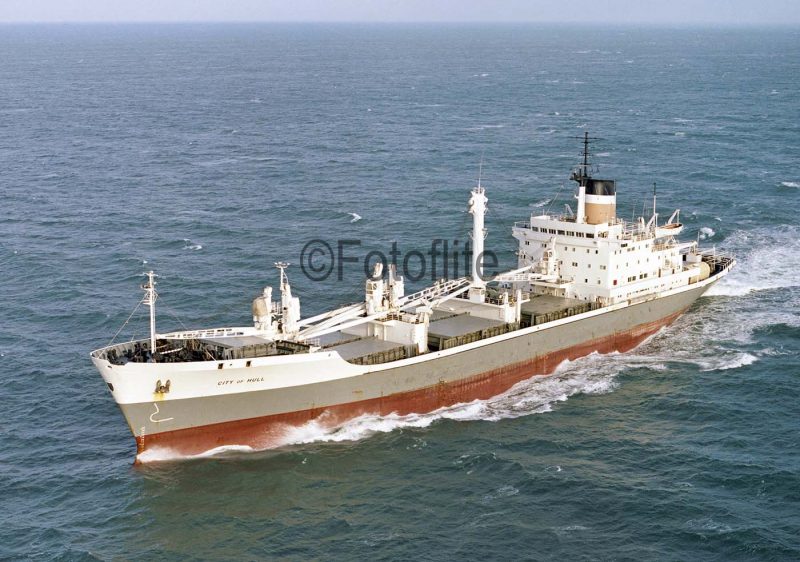
Postscript
The final trio of Ellerman cargo-liners followed the sextet of cargo-liners reviewed in this article as City of Liverpool and City of Hull from the Robb Caledon yard at Dundee in 1970/71, and their sister City of London from the former Charles Connell yard at Scotstoun in 1970, then trading as part of the ill fated Upper Clyde Shipbuilders Ltd. The trio had a very distinctive appearance of five electric cranes and derricks on a single mast, and five holds served by eight hatches, with their seven cylinder Doxford ‘J’ type two stroke single acting diesels of 17,500 bhp producing service speeds of 18.5 knots, having run on trials at a good two knots faster than their service speed. They were of 10,238 dwt and had modest container capability of 248 TEU when later adapted for the partial container trades.
In late 1981 after only ten to eleven years service, the trio was sold to Greek owners and renamed Marianthe (City of Liverpool), Sea Lord (City of London) and Sea Lady (City of Hull). The final dates of their arrival for breaking at scrap yards was as follows:-
- City of Liverpool of 1970 arrived at Kaohsiung on 16th September 1986 as Marianthe
- City of London of 1970 arrived at Kaohsiung during 1988 as Sea Lord
- City of Hull of 1971 arrived at Alang in India on 28th August 1996 as Magdalena
Ellerman City Liners Ltd. entered the Australasian, Far East and South African container trades via the Associated Container Transportation Ltd. (ACT), Trio Container Service with Ben Line and Japanese Lines (1973-1992), and Ellerman Harrison Container Line (1978-1989). Family ownership of Ellerman Lines Ltd. ended in 1983 when the Group was sold to the Barclay brothers, and four years later the Group was sold again to Trafalgar House and merged with Cunard Line to become Cunard-Ellerman. Later, it was also the subject of management takeovers, and then continued to operate in the Mediterranean and other trades until sold to Hamburg Sud of Germany in 2003, with all mention of the famous Ellerman name removed from trade literature when it was changed to that of Hamburg Sud in late October 2004. This most famous of all the big British liner fleets had lasted for just over a century, and the Ellerman name was consigned to an illustrious chapter in British maritime history.





Comments
Sorry, comments are closed for this item